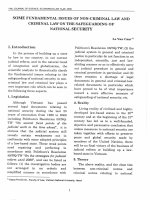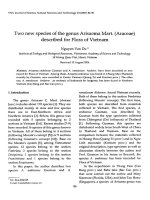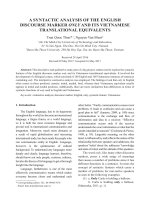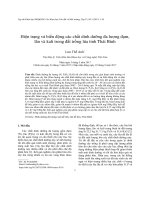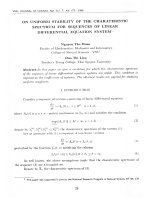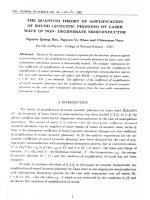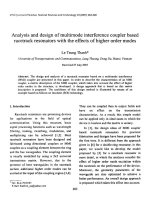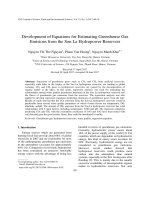DSpace at VNU: The English adverbial of time vs. the Vietnamese range topic of time
Bạn đang xem bản rút gọn của tài liệu. Xem và tải ngay bản đầy đủ của tài liệu tại đây (216.29 KB, 13 trang )
VNU Journal of Science, Foreign languages 28 (2012) 62-74
The English adverbial of time vs. the Vietnamese range topic
of time
To Minh Thanh
Department of English Linguistics and Literature, University of Social Sciences and Humanities, Vietnam
National University - Ho Chi Minh City, Vietnam, 10 - 12 Dinh Tien Hoang St., Dist 1, Ho Chi Minh City
Received 12 November 2011, Received in revised form 28 February 2012
Accepted 27 March 2012
Abstract. Differences between the function of the adverbial of time and that of the range topic of
time may lead language users who are Vietnamese to the risk of mistakenly translating the English
clause with the A of Time. A research has been carried on the basis of the theory of TopicComment presented by Cao Xuân Hạo (1991) to search for (i) dissimilarity with regard to word
order when translating into Vietnamese the English clause with one or more adverbials including
the adverbial of time, (ii) possible cases when native speakers apply the fronting of the adverbial
of time in the English clause, and (iii) any potential change in the meaning they would like to
convey with such fronting.
Key words: word order, fronting (movement), point of time, extent in time, sequence of events,
adverbial, range topic, principle of end-weight, perceptions through feeling, Topic, Comment,
topic emphasis.
English clause in question should be converted
into the range topic of Time1 at the beginning
of its Vietnamese equivalent. The abovementioned example shows that differences in
the role of the A of Time and that of the range
topic of Time may lead language users who are
Vietnamese to the risk of mistakenly translating
the English clause with the A of Time. This is
definitely the focus of this paper.
Introduction*
Somebody has translated from English to
Vietnamese the commercial note “Have you
had a Coke today?” by maintaining the word
order in English, resulting in “Bạn đã uống
Coca-Cola hôm nay chưa?” in which hôm nay
can also be considered as an adjectival to be the
post-nominal modifier of Coca-Cola. In order
to avoid such syntactic ambiguity, the
Vietnamese version “Hôm nay bạn đã uống
Coca-Cola chưa?” is recommended. This
realisation indicates that the adverbial of Time
(abbreviated to A of Time) at the end of the
1. Aim and theoretical background of
research
The research done for and reported in this
paper has been carried on the basis of the theory
_______
*
_______
Tel: 84-908 688 903
Email:
1
62
called “Khung đề thời gian” in Vietnamese
T.M. Thanh / VNU Journal of Science, Foreign languages 28 (2012) 62-74
- How different is the meaning conveyed by
(35)a from that of (36)a in the paper?
of Topic-Comment presented by Cao Xuân Hạo
(1991) [1]. The research aims at looking for (i)
dissimilarity with regard to word order when
translating into Vietnamese the English clause
with one or more adverbials including the A of
Time, (ii) possible cases when native speakers
apply the “fronting” (Dyvik, 1984, p. 10) [2] of
the A of Time in the English clause, and (iii) any
potential change in the meaning they would like
to convey with such fronting.
Following the view by Hurford and Heasley
(1984, p. 15-16) [3] that sentences are “ideal”
whereas utterances are “particular”, the research
starts with the English clause containing the A
of Time which occurs in the form of a simple
sentence and part of a complex sentence; it then
shifts to observe utterances in tokens of simple
sentences2 in a number of dialogues. Also,
within the scope of the research is the A of Time
in the form of (1) a close-class adverb like
tonight, sometimes,…; (2) an adverb phrase
basically with close-class adverb as head like
(just) then, (right) now,…; (3) a noun phrase
(abbreviated to NP) like last time, every day,…;
(4) a prepositional phrase (abbreviated to PP)
like in two days, from tomorrow,…; thus
excluding all of other realisations (Quirk et al,
1985, p. 489, 592) [4].
2. Scope and procedure of research
In order to achieve the above-mentioned
aims, the research is carried out under the
following procedure:
First comes the search for examples of the A
of Time either standing as the only modifier or
occurring together with another adverbial, of
the same or different type, at the end of the
English clause, which in turn either exists as a
simple sentence or is embedded as part of a
complex sentence of one type or another.
Secondly,
an
American
colleague
proofreads with great generosity all the
examples selected to guarantee that they are
those that native speakers of English would
normally say.
Then, the researcher tries her best to translate
the selected examples into Vietnamese,
grouping them into a number of categories as
presented in the paper.
Finally, up to ten native speakers are requested
to read for double check that the paper’s
selected examples are normal to them and
answer one or more of the following questions:
- When applying the fronting of the A of
Time as in (29)a or (34)a in the paper, do native
speakers of English mean something different?
Respectively, how do (2)a and (35)a differ in
meaning from (29)a and (34)a?
63
3. Result of Research
Presented in this paper3 is the result of the
research in the form of four main sections: the
first two present the obligatory or optional
fronting movement of the English A of Time
during the process of English-Vietnamese
translation; the third covers some tips to
translate the English clause with the A of Time;
the last section reveals some native speakers’
perceptions through feeling on possible change
_______
2
as compared to utterances of non-sentences, eg. short
phrases or single words
3
Conventions applied in this paper are:
- Original English clauses selected as illustration are
numbered, marked a and followed by the Vietnamese
translated version(s), marked either b, or both b and c, etc.;
- The lexical items in round brackets, like “(lại)” in (3)b-c,
may or may not be verbalized while those in square
brackets, like “[what’s on TV tonight]” in (10)a, are
embedded clauses;
- The three symbols “/”, “*”, and “?” respectively stand for
“or”, “unaccepted” and “possibly accepted.”
64
T.M. Thanh / VNU Journal of Science, Foreign languages 28 (2012) 62-74
of meaning when the fronting of the English A
of Time is applied.
Time should be in the form of a PP, more
strictly obeying “the principle of end-weight:
the tendency for long and complex elements to
be placed towards the end of a clause” (Biber et
al, 1999, p. 898) [5], resulting in (1-4)d:
3.1. Cases of obligatory fronting
During the process of English-Vietnamese
translation, the A of Time is obligatorily
fronted usually from the end of an English
clause to the beginning of its Vietnamese
equivalent to perform a new function there: the
range topic of Time – “the first part of a clause
that clearly indicates the conditions constituting
the frame of circumstance, time and space in
which what is stated in the second part of the
clause, the Comment, holds true” (Cao Xuân
Hạo, 1991, p. 82) [1]. The rule is applied under
certain circumstances:
(1)d. Tôi sẽ gọi cho chị vào tối nay.
(2)d. TV có gì trong chương trình của tối
hôm nay?
(3)d. Tại sao anh (lại) vắng mặt trong lần
họp trước?
(4)d. Tôi sẽ trả tiền cho chị trong hai ngày
nữa.
To native speakers of Vietnamese, (5-6)c
sound unnatural. The preferred translated
versions are undoubtedly (5-6)b, like (1-4)b,
those that clearly follow the Topic-Comment
structure (Cao Xuân Hạo, 1991, p. 23, 28) [1]
prominently observed in the Vietnamese clause
the range topic of Time of which is not in the
form of a PP.
3.1.1. The English clause in the form of a
simple sentence
3.1.1.1. With an A of Time in the final
position:
(1)a. I’ll call you tonight.
(5)a. I had no driver’s license/ did not have
a driver’s license before.
b. Tối nay tôi sẽ gọi cho chị.
c.?Tôi sẽ gọi cho chị tối nay.
b. Trước đây tôi không có bằng lái xe.
(2)a. What’s on TV tonight?
c.*Tôi không có bằng lái xe trước đây.4
b. Tối nay TV có gì?
d. Tôi không có bằng lái xe trong thời
gian trước đây.
c. ?TV có gì tối nay?
(3)a. Why were you absent last time?
(6)a. Why did Tom ignore us just now?
b. Tại sao lần trước anh (lại) vắng mặt?
b. Tại sao vừa rồi/mới đây Tom (lại)
phớt lờ bọn mình?
c.?Tại sao anh (lại) vắng mặt lần trước?
(4)a. I’ll pay you in two days.
b. Hai ngày nữa (thì) tôi sẽ trả tiền cho
c.*Tại sao Tom (lại) phớt lờ bọn mình
vừa rồi/ mới đây?
c.?Tôi sẽ trả tiền cho chị hai ngày nữa.
d.*Tại sao Tom (lại) phớt lờ bọn mình
trong vừa rồi/ vào mới đây?
chị.
Though it is not quite unaccepted, (1-4)c
sound more or less unnatural to native speakers
of Vietnamese. Thus, (1-4)b are much
preferred. Sentence-finally, the English A of
Time appears in the form of an NP, as in (1-3)a,
or a PP, as in (4)a, whereas the Vietnamese A of
Since neither vừa rồi nor mới đây is an NP,
no PP is formed as the result of the insertion of
_______
4
Trước đây, meaning “before”, can also be considered as an
adjectival to be the post-nominal modifier of the NP bằng
lái xe, meaning “driver’s license.” Another reason why (6)c
is not recommended is that it may lead to syntactic
ambiguity.
T.M. Thanh / VNU Journal of Science, Foreign languages 28 (2012) 62-74
65
trong or vào; consequently, (6)d is not as
grammatical as (5)d.
f.*Có 13 bạn đến dự tiệc vào ngày sinh nhật
của John hôm qua.
3.1.1.2. With an A of Time included
somewhere rather than in the final position:
g.*Có 13 bạn đến dự tiệc hôm qua vào ngày
sinh nhật của John.
(7)a. I now pronounce you man and wife.
h. Hôm qua có 13 bạn đến dự tiệc sinh nhật
của John.
b. Bây giờ đây cha tuyên bố hai con là vợ
chồng.
c.?Cha bây giờ đây tuyên bố hai con là vợ
chồng.
d.*Cha tuyên bố hai con là vợ chồng bây
giờ đây.
e.*Cha tuyên bố hai con là vợ chồng trong/
vào bây giờ đây.
The preferred translated version of the
vicar’s declaration in the wedding ceremony
held in a church is no doubt (7)b. With correct
pauses applied in speech, though there is no
explicit mark for the pauses in writing, (7)c
might also be accepted; it is obvious that the
insertion of a time expression in the form of an
NP somewhere within the Vietnamese clause
rather than in the initial position is far from
common. Again, (7)d is unaccepted, for the
Vietnamese A of Time can hardly take the form
of an NP sentence-finally, as was already
mentioned in 3.1.1.1., while (7)e is incorrect
because of the same reason as (6)d.
3.1.1.3. With a sequence of two adverbials
of Time in the final position:
Even when it has the range topic of Time in
the form of an NP and the remaining A of Time
in the form of a PP, which is long and
complicated enough to satisfy the principle of
end-weight, (8)b is unaccepted, like (8)c,
because the co-occurrence of the range topic of
Time at the beginning and an A of Time at the
end of the Vietnamese clause is impossible.
This recommends the act of translating the
remaining A of Time into the post-nominal
adjectival modifier of tiệc, the noun meaning
“tea” – a large meal in the early evening, in
(8)h. This only approved Vietnamese version is
also supported by the fact that the sequence of
two time expressions is not highly appreciated
both sentence-finally and sentence-initially in
the Vietnamese clause, as shown in (8)e-g.
Possibly accepted is (8)d, in which the range
topic of Time in the form of an NP precedes
that in the form of a PP, at least the “double
topic” (Dyvik, 1984, p. 3) [2] avoiding the
violation of the principle of end-weight.
(8)a. John had thirteen friends to tea on his
birthday yesterday.
3.1.1.4. With a final sequence of an A of
Time followed by an adverbial of another type,
of Condition (abbreviated to A of Condition),
for example:
b.*Hôm qua có 13 bạn đến dự tiệc vào
ngày sinh nhật của John.
(9)a. You look lovely today in your new
dress.
c.*Vào ngày sinh nhật của John có 13 bạn
đến dự tiệc hôm qua.
b. Hôm nay cô trông rất xinh trong bộ váy
áo mới này.
d.?Hôm qua vào ngày sinh nhật của John
có 13 bạn đến dự tiệc.
c.*Trong bộ váy áo mới này cô trông rất
xinh hôm nay.
e.*Vào ngày sinh nhật của John hôm qua
có 13 bạn đến dự tiệc.
d.?Hôm nay trong bộ váy áo mới này cô
trông rất xinh.
66
T.M. Thanh / VNU Journal of Science, Foreign languages 28 (2012) 62-74
e.*Trong bộ váy áo mới này hôm nay cô
trông rất xinh.
Husband: I’m busy right now.
f.*Cô trông rất xinh hôm nay trong bộ váy
áo mới này.
Dialogue 3:
g.*Cô trông rất xinh trong bộ váy áo mới
này hôm nay.
George: Tối nay (thì) mình đi ăn tiệm chứ?
Unlike (8)b, (9)b is fine because the cooccurrence of the range topic of Time at the
beginning and an A of Condition at the end of
the Vietnamese clause is approved. Again, the
double topic of Time-plus-Condition in (9)d
makes it possibly accepted, like the above (8)d.
Not accepted is the opposite of Condition-plusTime in (9)e, which is worsened by the flouting
of the principle of end-weight. This may
explain why (9)c is also unapproved. Still
again, the final sequence of two adverbials, one
of Time and the other of another type, is not
quite accepted in the Vietnamese clause, as
shown in (9)f-g.
3.1.1.5. With the translated A of Time
being fronted even in utterances as part of the
three following dialogues the first two
illustrate the range topic of Time, which can
be marked by thì, while the last one
exemplifies the Topic5, “the starting-point for
the message” (Halliday, 1994, p. 38) [6] being
marked by là:
Dialogue 1:
Minister of Education: I resign.
Bộ trưởng Bộ Giáo dục: Tôi xin từ chức.
Prime Minister: You’ll be free from
tomorrow.
Thủ tướng: Kể từ ngày mai (thì) anh/ chị
được tự do.
Dialogue 2:
Wife: Can you help me set the table?
Vợ: Anh giúp em bày bàn ăn được không?
_______
5
called “Chủ đề ” in Vietnamese
Chồng: Ngay bây giờ (thì) anh bận.
George: How about dinner out?
Beth: Thanks, but my essay is due
tomorrow morning.
Beth: Xin cám ơn, nhưng sáng mai là đến
hạn nộp bài luận của em.
3.1.2. The English clause as part of a
complex sentence
The above-mentioned explanations hold true
here when the English clause is embedded in a
complex sentence as it occurs as a simple
sentence in 3.1.1.
3.1.2.1. With an A of Time at the end of
the English embedded clause:
(10)a. Can you tell me [what’s on TV
tonight]?
b. Cho mình biết [tối nay TV có gì].
c. Cho mình biết ?[TV có gì tối nay].
d. Cho mình biết [TV có gì trong chương
trình của tối hôm nay].
(11)a. I wonder [why Tom ignored us just
now].
b. Tôi tự hỏi [tại sao vừa rồi/ mới đây Tom
(lại) phớt lờ bọn mình].
c. Tôi tự hỏi *[tại sao Tom (lại) phớt lờ bọn
mình vừa rồi/ mới đây].
d. Tôi tự hỏi *[tại sao Tom (lại) phớt lờ bọn
mình trong vừa rồi/ vào mới đây].
3.1.2.2. With a sequence of two adverbials
of Time at the end of the English embedded
clause:
(12)a. His mother said [that John had
thirteen friends to tea on his birthday
yesterday].
T.M. Thanh / VNU Journal of Science, Foreign languages 28 (2012) 62-74
b. Mẹ của John nói *[rằng hôm qua có 13
bạn đến dự tiệc vào ngày sinh nhật của John].
(14)a. Did you go to the movies last night?
c. Mẹ của John nói *[rằng vào ngày sinh
nhật của John có 13 bạn đến dự tiệc hôm qua].
c.*Mày đi đêm hôm qua xem phim hả?
d. Mẹ của John nói ?[rằng hôm qua vào
ngày sinh nhật của John có 13 bạn đến dự
tiệc].
e. Mẹ của John nói *[rằng vào ngày sinh
nhật của John hôm qua có 13 bạn đến dự tiệc].
f. Mẹ của John nói *[rằng có 13 bạn đến dự
tiệc vào ngày sinh nhật của John hôm qua].
g. Mẹ của John nói *[rằng có 13 bạn đến dự
tiệc hôm qua vào ngày sinh nhật của John].
h. Mẹ của John nói [rằng hôm qua có 13
bạn đến dự tiệc sinh nhật của John].
3.2. Cases of optional fronting
During the process of English-Vietnamese
translation, the A of Time is optionally fronted
from the end of an English clause to the
beginning of its Vietnamese equivalent to
perform a new function there – the range topic
of Time. The rule is applied under certain
circumstances:
3.2.1. When the English clause ends with a
sequence of an adverbial of Space (abbreviated
to A of Space) before an A of Time:
(13)a. I heard that on the radio yesterday, too.
b. Anh cũng nghe điều đó trên radio hôm
qua rồi.
c.?Anh cũng nghe điều đó hôm qua trên
radio rồi.
d. Hôm qua anh cũng nghe điều đó trên
radio rồi.
e.*Trên radio anh cũng nghe điều đó hôm
qua rồi.
f.?Hôm qua trên radio anh cũng nghe điều
đó rồi.
g.*Trên radio hôm qua anh cũng nghe điều
đó rồi.
67
b. Mày đi xem phim đêm hôm qua hả?6
d. Đêm hôm qua mày đi xem phim hả?
e.?Đến rạp chiếu phim mày đi đêm hôm
qua hả?
f.*Đêm hôm qua đến rạp chiếu phim/ xem
phim mày đi hả?
g.*Đến rạp chiếu phim/ Xem phim đêm
hôm qua mày đi hả?
Sentence-finally, the sequence of an A of
Time after an adverbial of another type,
especially an A of Space, is quite common in
both English and Vietnamese, preventing (1314)b from being rare; the sequence of a time
expression before another adverbial is more
marked, as proved by the less common (13)c
and the unaccepted (14)c. Recommended to be
the first version selected for translation are (1314)d, with the range topic of Time and a final
adverbial of another type; the opposite (13-14)e
sound really strange because the order of the
range topic of Space and a final A of Time is
rare in the Vietnamese clause. The double topic
of Time-plus-Space makes (13)f less rare while
that of Space-plus-Time makes (13-14)g too
unnatural to be approved. While the degree of
acceptability is not always easy to determine in
comparing (13)f with (14)f, the feeling of
naturalness can be strengthened if the A of Time
in (13)a-b, for example, turns to be a bit longer
and more complicated in structure to meet the
principle of end-weight, resulting in (15)a-b:
(15)a. I heard that on the radio yesterday
morning, too.
_______
6
The word-by-word translated version (16)b’ does not
convey the real meaning of (16)a, failing to make native
speakers of Vietnamese understand in the same way as
native speakers of English do:
(16)b’. Mày đi đến rạp chiếu phim đêm hôm qua hả?
Did you go to the building where films are shown
last night?
68
T.M. Thanh / VNU Journal of Science, Foreign languages 28 (2012) 62-74
b. Anh cũng nghe điều đó trên radio vào
sáng ngày hôm qua rồi.
3.2.2. When the English clause which ends
with a sequence of an A of Space before an A of
Time, either finite as in (16)a or non-finite as in
(17)a, is embedded in a complex sentence:
in (17)d as optional; that (16)b is possibly
accepted casts doubt on the obligatory fronting
in (16)d. It is recommended to translate the
embedded clause from non-finite in English to a
finite form in Vietnamese, i.e. the subject ông
should be overt:
(16)a. I wonder [why Tom ignored us on the
street just now].
(17)d’. Ông hối tiếc [là/ rằng sáng nay ông đã
nổi cáu ở chỗ làm].
b. Tôi tự hỏi ?[tại sao Tom đã phớt lờ bọn
mình ngoài phố vừa rồi].
f’. Ông hối tiếc [là/ rằng sáng nay ở chỗ
làm ông đã nổi cáu].
c. Tôi tự hỏi *[tại sao Tom đã phớt lờ bọn
mình vừa rồi ngoài phố].
3.2.3. When the English clause embodies a
modal expression together with a final
sequence of an A of Space followed by an A of
Time:
d. Tôi tự hỏi [tại sao vừa rồi Tom đã phớt
lờ bọn mình ngoài phố].
e. Tôi tự hỏi *[tại sao ngoài phố Tom đã
phớt lờ bọn mình vừa rồi].
(18)a. I am supposed to go to Hanoi this
weekend.
b. Lẽ ra cuối tuần này tôi phải đi Hà Nội.
f. Tôi tự hỏi ?[tại sao vừa rồi ngoài phố
Tom đã phớt lờ bọn mình].
c.?Lẽ ra tôi phải đi Hà Nội cuối tuần này.
e. Tôi tự hỏi *[tại sao ngoài phố vừa rồi
Tom đã phớt lờ bọn mình].
d. Lẽ ra tôi phải đi Hà Nội vào cuối tuần
này.
(17)a. He regrets [losing his temper at work this
morning].
There are two acts of fronting during the
process of translation: the A of Time becomes
the range topic of Time while the modal
expression am supposed to turns into a
combination of the range topic of Modality lẽ
ra and the modal verb phải, resulting in the
double topic typical of the Vietnamese clause in
(18)b. It is the sequence of an A of Space
before an A of Time that makes (18)a common
in English and (18)b accepted in Vietnamese,
considering the existence of the range topic of
Modality sentence-initially. At the end of the
Vietnamese clause should be the A of Time in
the form of a PP, as in (18)d, however.
b. Ông hối tiếc [đã nổi cáu ở chỗ làm sáng
nay].
c. Ông hối tiếc ?[đã nổi cáu sáng nay ở chỗ
làm].
d. Ông hối tiếc [sáng nay đã nổi cáu ở chỗ
làm].
e. Ông hối tiếc *[ở chỗ làm đã nổi cáu sáng
nay].
f. Ông hối tiếc *[sáng nay ở chỗ làm đã nổi
cáu].
g. Ông hối tiếc *[ở chỗ làm sáng nay đã
nổi cáu].
The above explanations hold basically true
here when the English clause is embedded in a
complex sentence as it occurs as a simple
sentence in 3.2.1. However, that (17)b is quite
accepted considers the fronting of the A of Time
3.2.4. When the English clause ends with a
sequence of two adverbials of Time, “the
superordinate adjunct (the one denoting the
more extended period)” (Quirk et al, 1985, p.
533) [4] optionally being fronted:
(19)a. We’ll meet tonight after the show.
T.M. Thanh / VNU Journal of Science, Foreign languages 28 (2012) 62-74
69
b. Mình sẽ gặp nhau đêm nay, sau buổi biểu
diễn.
b. Ngay bây giờ (thì) tôi không thể trả lời
câu hỏi của chị được.
c. Đêm nay mình sẽ gặp nhau, sau buổi
biểu diễn.
c. Tôi không thể trả lời câu hỏi của chị ngay
bây giờ được.
This holds true even when there is an A of
Space before those of Time:
(23)a. What do you usually do in your free
time?
(20)a. I was in New York last year before the
first snow fell.
b. Lúc rảnh rỗi/ Khi rảnh rỗi/ Những khi
rảnh rỗi (thì) anh thường làm gì?
b. Tôi ở New York hồi năm ngoái, trước khi
những bông tuyết đầu tiên rơi.
c. Anh thường làm gì lúc rảnh rỗi/ khi rảnh
rỗi/ những khi rảnh rỗi/ vào thời gian rảnh?
c. Năm ngoái tôi ở New York, trước khi
những bông tuyết đầu tiên rơi.
Such alternative use can also be observed in
the following dialogues:
3.2.5. When the English embedded clause is
finite and has its adverbial of Sequence of
Events (abbreviated to A of Sequence) (Tô Minh
Thanh, 2011, p. 262) [7] fronted, i.e. converted
into the range topic of Time, while the A of
Time kept in the final position to meet the
principle of end-weight, there exists a change in
form during the process of translation from an
NP, like last night in (21)a, quoted from Cook
(1989, p. 7) [8], to a PP, like vào đêm hôm qua
in (21)b-c. That (21)c may also be accepted
shows how flexible the syntactic-semantic
function of sau đó is in the Vietnamese clause:
the range topic of Time in (21)b or the A of
Sequence in (21)c:
(21)a. I thought it was right to come to a
decision [when I next met them last night].
b. Tôi nghĩ đã đến lúc đưa ra quyết định
[khi sau đó tôi gặp họ vào đêm hôm qua].
c. Tôi nghĩ đã đến lúc đưa ra quyết định
?[khi tôi sau đó gặp họ vào đêm hôm qua].
3.2.6. When the English clause has at least
two Vietnamese equivalent versions the range
topic of Time of the first can be marked by thì,
like (22-23)b, whereas the alternative
expression exists without thì, like (22-23)c:
(22)a. I can’t answer your question right now.
Dialogue 4:
Wife: Who is picking up the children
today?
Vợ: Hôm nay (thì) ai sẽ đón con?
Husband: I’ve got a meeting at 3.30.
Chồng: Lúc 3 giờ rưỡi (thì) anh có một
cuộc họp./ Anh có một cuộc họp vào lúc 3 giờ
rưỡi.
Dialogue 5:
Tourist: Do you expect a lot of rain this
month?
Du khách: Tháng này (thì) trời có nhiều
mưa không?
Tour guide: It hardly ever rains in March.
Hướng dẫn viên: Tháng ba (thì) trời hầu như
chưa mưa./ Trời hầu như chưa mưa
vào tháng ba.
The above-mentioned explanations hold
true here even when the English clause occurs
not as a simple sentence but as part of a
complex sentence:
(24)a. I’m afraid [that I can’t answer your
question right now].
b. Tôi e [rằng ngay bây giờ (thì) tôi không
thể trả lời câu hỏi của chị được].
70
T.M. Thanh / VNU Journal of Science, Foreign languages 28 (2012) 62-74
c. Tôi e [rằng tôi không thể trả lời câu hỏi
của chị ngay bây giờ được].
function as the range topic of Time in its
translated version.
3.2.7. When the English embedded clause is
non-finite and has two Vietnamese equivalents
which can both be marked by là, as in (25)b-c:
As for the Vietnamese clause exclusively,
(1) the range topic of Time is undoubtedly
prominent, (2) the double topic is more
common than the dual final adverbials, (3)
Time-plus-Space is approved in the double
topic while Space-plus-Time is more accepted
in the dual final adverbial, and (4) the range
topic of Time plus a final adverbial of another
type, especially of Space, not the range topic of
Space plus a final A of Time, is recommended.
(25)a. I regret [drinking so much last night].
b. Tôi hối tiếc [(là) đêm hôm qua đã uống
quá nhiều].
c. Tôi hối tiếc [(là) đã uống quá nhiều (vào)
đêm hôm qua].
3.2.8. When the English clause has its A of
Time referring to Extent in Time, not Point of
Time7 (Tô Minh Thanh, 2011, p. 49-50, 105106) [7]:
(26)a. John’s sister has been in the hospital for
a week.
b. Chị/ Em gái của John đã nằm bệnh viện
một tuần rồi.
c. *Một tuần rồi (thì) chị/em gái của John
đã nằm bệnh viện.
(27)a. They waited until the last minute.
b. Họ đã đợi đến phút cuối cùng.
c. *Đến phút cuối cùng (thì) họ đã đợi.
(28)a. Can I talk to you for a while?
b. Tôi nói chuyện với chị một lát được
không?
c. *Một lát (thì) tôi nói chuyện với chị được
không?
In summary, what has been presented in the
first two sections helps to prove that:
As for both English and Vietnamese, the
final sequence of an A of Time after an
adverbial of another type, especially an A of
Space, is quite common; also common is the A
of Time of an English sentence being fronted to
_______
7
Respectively, Point of Time (Thời điểm) and Extent in
Time (Thời đoạn) are referred to as “Time position” and
“Time duration” by Quirk et al (1985, p. 487) [4].
The above-mentioned assertions hold
basically true even when the English clause and
its translated version occur not only as a simple
sentence but also as part of a complex sentence.
3.3. Tips for translating the English A of
Time
The analysis in the paper’s first two
sections supports the following tips to deal with
the A of Time during the process of EnglishVietnamese translation:
Tip 1: Apply frequently in the Vietnamese
clause the range topic of Time as well as the
double topic, the first member being Time; pay
attention to the Vietnamese final sequence of
two adverbials, the last member being Time.
Tip 2: Do not change the Topic-Comment
structure when translating from English to
Vietnamese, as in (29-32)a-b, if there is no
compelling reason:
(29)a. Tonight I’ll call you.
b. Tối nay tôi sẽ gọi cho chị.
(30)a. After summer comes autumn.
b. Hết hè thì thu tới.
(31)a. After a storm comes a calm.
b. Sau cơn dông là lúc trời yên, biển lặng.
(32)a. I like to sleep until noon, and sometimes
I sleep later.
T.M. Thanh / VNU Journal of Science, Foreign languages 28 (2012) 62-74
b. Tôi thích ngủ đến tận 12 giờ trưa, và đôi
khi tôi còn ngủ trễ hơn.
71
people in (34)a as “the given information.”
Thus in Dyvik’s belief, the English language,
like the Vietnamese language, does distinguish
the range topic of Time in (34)a from the A of
Time in (35)a, due to their different functions to
convey meaning. Unfortunately, Dyvik’s
assertion is still far from convincing: Are (35)a
and the following (36)a synonymous (Tô Minh
Thanh, 2011, p. 285-286) [7]?
This tip works even when there are two or
more adverbials, including an A of Time, in the
English clause in which the co-occurrence of an
adverbial of Frequency (abbreviated to A of
Frequency) (Quirk et al, 1985, p. 482) [4] and
an A of Time is observed in (33)a-b:
(33)a. In the United States there is usually no
school on weekends.
(36)a. The same five thousand people pass
through that door every day.
b. Ở Mỹ thường không có lớp học vào ngày
nghỉ cuối tuần.
b. Cùng năm ngàn người ấy đi qua cánh cửa
đó mỗi ngày.
Tip 3: Try to distinguish the role of the A of
Time from that of the range topic of Time,
which may lead language users who are
Vietnamese to the risk of mistakenly translating
the English clause with the A of Time.
According to Dyvik (1984, p. 10) [2], since
“fronting of constituents is a way of
topicalization” in the English language, every
day, as the range topic of Time in (34)a, brings
to the sentence a meaning that is quite different
from that of (35)a with every day playing the
role of the A of Frequency at the end of the
clause in question:
3.4. Cases of fronting the English A of Time
and their potential change in meaning
In order to find out satisfactory answers to
the issue regarding the fronting of the English A
of Time, as in (29)a and (34)a, and the
difference in meaning that the two sentences
may have as compared respectively to that of
(2)a and (35)a, I have tried my best to contact a
number of friends and colleagues8 whose
mother tongue is English to ask for their
personal opinions on which the following
generalisation is based:
(34)a. Every day five thousand people pass
through that door.
3.4.1. In general, the unmarked position for
the time expression is at the end; therefore, the
fronting of the A of Time would be rather less
common. The main difference would depend
on topic emphasis. For example, each of the
following pairs of sentences conveys basically
the same message, but maybe there is a subtle
shade of difference in meaning when the
fronting of the A of Time is applied:
b. Mỗi ngày năm ngàn người đi qua cánh
cửa đó.
(35)a. Five thousand people pass through that
door every day.
b. Năm ngàn người đi qua cánh cửa đó mỗi
ngày.
In Dyvik’s explanation, (34)a simply
indicates the number of persons who pass
through that door every day without implying,
like (35)a, that the act of passing through that
door is performed by the same five thousand
people. This is because, as the range topic of
Time, every day does not mark five thousand
The emphasis in (29)a is on when the call
will be made; as for (2)a, the emphasis is on the
action of calling as well as who will be calling;
The emphasis in (35)a is on the number of
people, as for (34)a, the emphasis is on the
_______
8
who wish to remain anonymous in this paper
72
T.M. Thanh / VNU Journal of Science, Foreign languages 28 (2012) 62-74
repetitive or ongoing nature of the activity.
Such different shades of meaning are still
correct in (37-38)a, with the existence of
another time reference since then what is stated
in the main clause holds true:
(37)a. Every day since the building opened in
2002 five thousand people have passed through
that door.
b. Mỗi ngày từ khi tòa nhà đi vào hoạt động
năm 2002 năm ngàn người đi qua cánh cửa đó.
(38)a. Five thousand people have passed
through that door every day since the building
opened in 2002.
b. Năm ngàn người đi qua cánh cửa đó mỗi
ngày từ khi tòa nhà đi vào hoạt động năm 2002.
3.4.2.
More
specifically,
sentences
beginning with the time expression would be
used in formal situations and thus are not very
common; they have much more impact
than those with an A of Time at the end.
An example is the famous message sent to
American paratroopers on the eve of D-Day9:
'Tonight is the night of nights.' This is part of
an announcement made to an audience, to add
emphasis and importance to the time being
mentioned and to the announcement itself. In
everyday speech, the sentences beginning with
the time expression might also be used to place
emphasis on the time so that it is not forgotten:
Dialogue 6:
Jack: We're going fishing on Wednesday
and hunting on Thursday, right?
Jack: Bọn mình sẽ đi câu vào thứ Tư và đi
săn vào thứ Năm, đúng không?
Kevin: No, Wednesday is hunting and
Thursday is fishing.
_______
9
This was June 6, 1944 when during World War II, the
allies landed in France to begin the spread of their forces
through Europe, under the command of General
Eisenhower to liberate Europe from the atrocities of
Hitler.
Kevin: Không, thứ Tư (thì) đi săn còn thứ
Năm (mới) đi câu.
But this is a flexible rule: it is just as
acceptable for Kevin to say 'No, hunting is on
Wednesday and fishing is on Thursday.' And
this is a fairly common use of the item.
3.4.3. As for when native speakers of
English apply the fronting of the A of Time, it is
more common to use fronting with the A of
Frequency (every day, each morning,
sometimes, most Saturdays, etc.), whereas
fronting with the A of Point of Time or A of
Extent in Time (tonight, tomorrow, yesterday,
on Saturday, etc.) seems a bit less common.
Therefore, (34)a sounds completely natural to
native speakers of English, whereas the
speakers would not use (29)a unless they really
emphasized when they were going to call, or
wanted to make a contrast (e.g. 'I usually forget
to call, but tonight I'll (definitely) call you', or
'Most nights I call Sandra, but tonight I'll call
you').
3.4.4. It is interesting to come up with the
fact that native speakers’ perceptions through
feeling on possible change of meaning when the
fronting of the English A of Time is applied are
not exactly the same. Below is a personal
opinion:
“There is a full semantic range in syntax as
well as lexicography to be considered in order
to distinguish the meanings of the three
sentences numbered (34-36)a: (35)a does not
exclude the possibility of referring to the same
group of people carrying out the daily habitual
action; it is more suggestive of the situation
described in (36)a than (34)a is, but is by no
means confined to it; likewise, while (34)a is
less suggestive of the situation in (36)a than
(35)a, neither is it exclusive of it.
This semantic range is useful to summarize
analogy with other situations (as if the topic
T.M. Thanh / VNU Journal of Science, Foreign languages 28 (2012) 62-74
were about other doors or what the group of
people do everyday) if applicable, or to
accommodate any ambiguity on the part of the
writer/speaker, but the grammatical tools are
not required and native speakers of English
can use (34)a and (35)a in free variation.
Only (36)a is bound to the 500 people being
identical as opposed to a different set of 500
people on any given day.”
And here is another personal opinion,
stating that neither (35)a is more nor (34)a is
less suggestive of the situation described in
(36)a and that while it is possible for (35)a not
to exclude the possibility of referring to the
same group of people carrying out the daily
habitual action, it is certainly not clear that the
speaker is mentioning the same five thousand
people.
It’s time to come to the conclusion that,
unlike Vietnamese, English does not distinguish
the range topic of Time from the A of Time, for
(34)a and (35)a are synonymous to the native
speakers of English who have been involved in
this paper, expressing their disagreement with
Dyvik’s belief. Also to all of them, (36)a is
more specific than the other two because of the
word “same.”
Conclusion
There are few situations where English
sentences would begin with the time
expression, i.e. the fronting of the A of Time is
marked in the English clause. It is topic
emphasis that determines the choice
concerning the position of the A of Time: at the
beginning of the English clause if the focus is
the time being mentioned; at the end of the
English clause if the interlocutor would like to
focus on the action itself and/or the person(s)
who do(es) it. Since the unmarked position for
73
the time expression is at the end, English
sentences beginning with a time expression
would be used in formal situations and thus are
not very common. In everyday speech,
however, native speakers of English may
flexibly apply the fronting of the A of Time or
not because both are just acceptable, with
basically the same message added by a subtle
shade of difference in the meaning being
conveyed.
The range topic of Time is so common at
the beginning of the Vietnamese clause that this
case is definitely unmarked in Vietnamese. That
is the reason why during the process of EnglishVietnamese translation, the A of Time is almost
obligatorily fronted usually from the end of an
English clause to the beginning of its
Vietnamese version, following the TopicComment structure prominently observed in the
Vietnamese clause. Such fronting is not
obligatory but optional in a number of cases:
+ When the translated version has its final A
of Time in the form of not an NP but a PP so
that the principle of end-weight may be obeyed
strictly;
+ When there exists a final sequence of an
A of Space before an A of Time, which is quite
common in the two languages in question;
+ When the English clause has its final A of
Time referring to Extent in Time.
Hopefully, what has been presented draws
attention of those who are involved in EnglishVietnamese translation to such a delicate choice
of either maintaining the A of Time at the end or
converting it into the range topic of Time at the
beginning of the translated version. There is no
doubt that such a choice, however small it is,
plays a meaningful role in language learning in
general, in the practice of translation in
particular.
74
T.M. Thanh / VNU Journal of Science, Foreign languages 28 (2012) 62-74
English language, London and New York:
Longman Group Ltd, 1985.
Bibliography
[1] Cao Xuân Hạo, Tiếng Việt – Sơ thảo ngữ pháp
chức năng (The Vietnamese Language – A
Rough Draft on Functional Grammar), Hanoi:
Publishing House of Social Sciences, 1991.
[5] D. Biber, S. Johansson, G. Leech, S. Conrad,
and E. Finegan, Longman grammar of spoken
and written English, London: Pearson Education
Ltd, 1999.
[2] H.J.J. Dyvik, Subject or Topic in Vietnamese.
Universiy of Bergen, Norway. (provided in the
form of a typed material in 1994 to Department
of Vietnamese Literature and Linguistics, Ho
Chi Minh City University of Pedagogy by Mr.
Olaf Husby), 1984.
[6] M.A.K. Halliday, An introduction to functional
grammar, Second Edition, London: Arnold,
1994.
[3] J. R. Hurford and B. Heasley, Semantics – A
course book. Cambridge: Cambridge University
Press, 1984.
[4] R. Quirk, S. Greenbaum, G. Leech, and J.
Svartvik, A comprehesive grammar of the
[7] Tô Minh Thanh, Vai nghĩa trong câu trần thuật
tiếng Việt và tiếng Anh (Semantic Roles in
Vietnamese and English Declaratives), Ho Chi
Minh City: Publishing House of Vietnam
National University - Ho Chi Minh City, 2011.
[8] G. Cook, Discourse. Oxford: Oxford University
Press, 1989.
Trạng ngữ thời gian trong tiếng Anh và khung đề thời gian
trong tiếng Việt
Tô Minh Thanh
Khoa Ngữ văn Anh, Trường Đại học Khoa học Xã hội và Nhân văn, Đại học Quốc gia TP. Hồ Chí Minh,
10-12 Đinh Tiên Hoàng, Quận 1, TP. Hồ Chí Minh, Việt Nam
Việc không ý thức đến sự khác biệt về chức năng của trạng ngữ chỉ thời gian và khung đề thời
gian có khả năng dẫn đến tình trạng người Việt dịch sai các câu tiếng Anh có chứa trạng ngữ chỉ thời
gian. Dựa trên lý thuyết về Đề-Thuyết đã được trình bày trong công trình của Cao Xuân Hạo (1991),
nghiên cứu này tập trung tìm hiểu (i) sự không tương thích về trật tự từ có thể xảy ra khi dịch sang
tiếng Việt câu tiếng Anh có một hay hơn một trạng ngữ trong đó có trạng ngữ chỉ thời gian, (ii) những
trường hợp người bản ngữ dùng trạng ngữ chỉ thời gian ở đầu câu tiếng Anh, và (iii) những thay đổi
tiềm ẩn về nghĩa biểu đạt do sự thay đổi vị trí này tạo nên.
Từ khóa: trật tự từ ngữ, sự dịch chuyển về phía trước hoặc lên đầu câu, thời điểm, thời đoạn, chuỗi
sự kiện, trạng ngữ, khung đề, nguyên tắc trọng hậu, cảm thức, Chủ đề, Thuyết, việc nhấn mạnh chủ đề.
